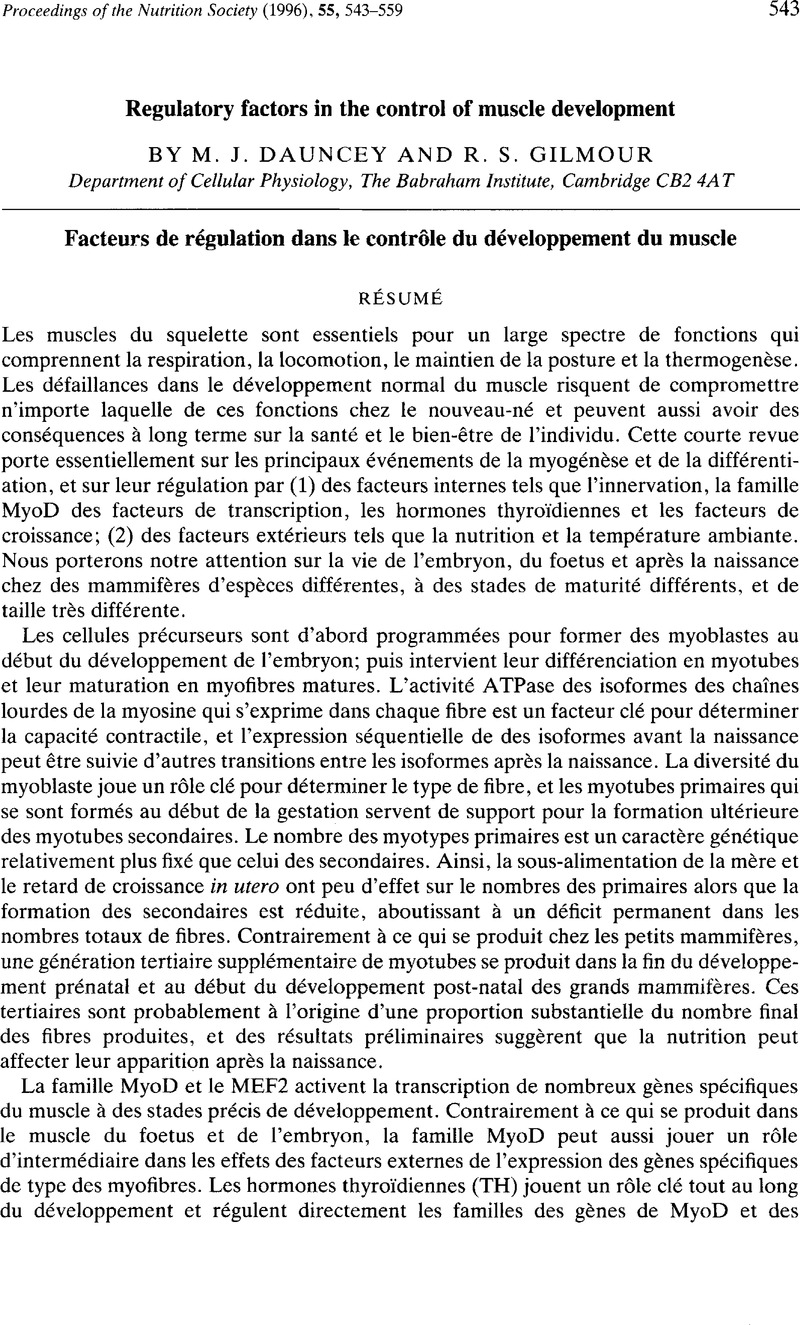Crossref Citations
This article has been cited by the following publications. This list is generated based on data provided by Crossref.
Harrison, A. P.
Tivey, D. R.
Clausen, T.
Duchamp, C.
and
Dauncey, M. J.
1996.
Role of thyroid hormones in early postnatal development of skeletal muscle and its implications for undernutrition.
British Journal of Nutrition,
Vol. 76,
Issue. 6,
p.
841.
Symonds, Michael E.
and
Clarke, Lynne
1996.
Influence of thyroid hormones and temperature on adipose tissue development and lung maturation.
Proceedings of the Nutrition Society,
Vol. 55,
Issue. 1B,
p.
561.
Dauncey, M. J.
1997.
From early nutrition and later development...to underlying mechanisms and optimal health.
British Journal of Nutrition,
Vol. 78,
Issue. s2,
p.
S113.
Brandstetter, Anna M
Picard, Brigitte
and
Geay, Yves
1998.
Muscle fibre characteristics in four muscles of growing male cattle.
Livestock Production Science,
Vol. 53,
Issue. 1,
p.
25.
Fowden, Abigail L.
Li, Juan
and
Forhead, Alison J.
1998.
Glucocorticoids and the preparation for life after birth: are there long-term consequences of the life insurance?.
Proceedings of the Nutrition Society,
Vol. 57,
Issue. 01,
p.
113.
Wray-Cahen, C. Diane
Kerr, David E.
Evock-Clover, Christina M.
and
Steele, Norman C.
1998.
REDEFINING BODY COMPOSITION: Nutrients, Hormones, and Genes in Meat Production.
Annual Review of Nutrition,
Vol. 18,
Issue. 1,
p.
63.
Brameld, Jonh M.
Buttery, Peter J.
Dawson, Janet M.
and
Harper, Jane M. M.
1998.
Nutritional and hormonal control of skeletal-muscle cell growth and differentiation.
Proceedings of the Nutrition Society,
Vol. 57,
Issue. 02,
p.
207.
ROSSDALE, P.D.
and
OUSEY, JENNIFER C.
1998.
The Dorothy Russell Havemeyer Foundation Third International Workshop on Equine Perinatology: Comparative Aspects.
Equine Veterinary Journal,
Vol. 30,
Issue. 6,
p.
455.
Katsumata, M.
Burton, K. A.
Li, J.
and
Dauncey, M. J.
1999.
Suboptimal energy balance selectively up‐regulates muscle GLUT gene expression but reduces insulin‐dependent glucose uptake during postnatal development.
The FASEB Journal,
Vol. 13,
Issue. 11,
p.
1405.
White, P.
Cattaneo, D.
and
Dauncey, M. J.
2000.
Postnatal regulation of myosin heavy chain isoform expression and metabolic enzyme activity by nutrition.
British Journal of Nutrition,
Vol. 84,
Issue. 2,
p.
185.
Damon, Marie
Vincent, Annie
Lombardi, Assunta
and
Herpin, Patrick
2000.
First evidence of uncoupling protein-2 (UCP-2) and -3 (UCP-3) gene expression in piglet skeletal muscle and adipose tissue.
Gene,
Vol. 246,
Issue. 1-2,
p.
133.
Katsumata, M.
Cattaneo, D.
White, P.
Burton, K.A.
and
Dauncey, M.J.
2000.
Growth Hormone Receptor Gene Expression in Porcine Skeletal and Cardiac Muscles Is Selectively Regulated by Postnatal Undernutrition.
The Journal of Nutrition,
Vol. 130,
Issue. 10,
p.
2482.
White, P.
Burton, K A.
Fowden, A. L.
and
Dauncey, M. J.
2001.
Developmental expression analysis of thyroid hormone receptor isoforms reveals new insights into their essential functions in cardiac and skeletal muscles.
The FASEB Journal,
Vol. 15,
Issue. 8,
p.
1367.
Dauncey, M. J.
White, P.
Burton, K. A.
and
Katsumata, M.
2001.
Nutrition–hormone receptor–gene interactions: implications for development and disease.
Proceedings of the Nutrition Society,
Vol. 60,
Issue. 1,
p.
63.
Li, J.
Forhead, A. J.
Dauncey, M. J.
Gilmour, R. S.
and
Fowden, A. L.
2002.
Control of growth hormone receptor and insulin‐like growth factor‐I expression by cortisol in ovine fetal skeletal muscle.
The Journal of Physiology,
Vol. 541,
Issue. 2,
p.
581.
Lefaucheur, Louis
Ecolan, Patrick
Barzic, Yves-Marie
Marion, Julia
and
Le Dividich, Jean
2003.
Early Postnatal Food Intake Alters Myofiber Maturation in Pig Skeletal Muscle.
The Journal of Nutrition,
Vol. 133,
Issue. 1,
p.
140.
Sartori, José Roberto
Gonzales, Elisabeth
Macari, Marcos
Dal Pai, Vitalino
and
Oliveira, Henrique Nunes de
2003.
Tipos de fibras no músculo flexor longo do hálux de frangos de corte submetidos ao estresse pelo calor e frio e alimentados em "pair-feeding".
Revista Brasileira de Zootecnia,
Vol. 32,
Issue. 4,
p.
918.
Heyer *, A.
Andersson, H.K.
Lindberg, J.E.
and
Lundström, K.
2004.
Effect of extra maternal feed supply in early gestation on sow and piglet performance and production and meat quality of growing/finishing pigs.
Acta Agriculturae Scandinavica, Section A - Animal Science,
Vol. 54,
Issue. 1,
p.
44.
Fahey, A. J.
Brameld, J. M.
Parr, T.
and
Buttery, P. J.
2005.
Ontogeny of factors associated with proliferation and differentiation of muscle in the ovine fetus1,2.
Journal of Animal Science,
Vol. 83,
Issue. 10,
p.
2330.
Sayer, Avan Aihie
and
Cooper, Cyrus
2005.
Fetal programming of body composition and musculoskeletal development.
Early Human Development,
Vol. 81,
Issue. 9,
p.
735.



